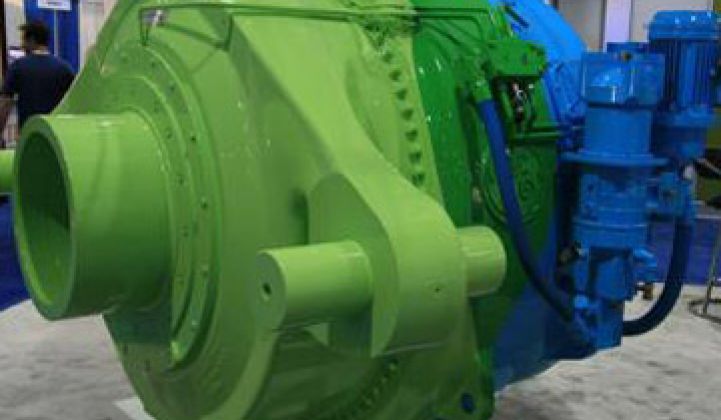With 1,100 turbines in the immediate vicinity of its two new Minnesota wind service centers and another 1,000 machines coming on line in the next one to two years, Diarmaid Mulholland, GE’s General Manager, sees no reason to be overly concerned about the temporary downturn in the world economy and the associated short-term falloff in U.S. wind development.
“The timing could be a little better,” Mulholland admitted, “but I’d like to think we’re going to be here for the next two or three cycles and services have a way of bringing lifetime value to owners, not just in year one or two.”
The new Albert Lea and Pipestone service centers, like the ones GE operates in Sweetwater, Texas, and Tehachapi, California, are designed to increase value for purchasers of GE turbines. “Production is the basic measure of an operating asset,” Mulholland said. “The Midwest is where the big wind resource is and these service centers help our customers capture that wind and increase their production.”
Mulholland is based at GE’s main control center in Schenectady, New York, where the company manages the 6,000-turbine North American fleet of mainly GE 1.5-megawatt and 2.5-megawatt machines. The intent of developing regional centers, he said, is to strategically place GE’s operations and maintenance (O&M) expertise “to give the owners of those turbines access to our resources, our skills, our people and a technology that will keep those units running at 97, 98, 99 percent availability.”
Together, the Minnesota centers employ 50 people. Aside from regularly scheduled maintenance, the regional centers can respond as turbine problems emerge. “If we see something develop overnight,” Mulholland explained, referring to the twenty-four/seven monitoring in Schenectady, “a signal is sent to the local service center. When those guys wake up in the morning, they are told where to go, what to do,” and people at the regional center “have tooling ready, have components ready, and they’re dispatched for the day.”
Everything the deployed technicians need to know is made available to them via a GE-proprietary BlackBerry-like device. “It’s a very specialized device,” Mulholland said. “Using it, the field technicians can access procedures, drawings, identify parts and contact our engineering center.”
Mulholland said GE works with local community colleges to recruit people, and it trains these recruits rigorously -- “real training on real equipment,” he said. As part of the program, the trainees are provided with a GE 1.5-megawatt turbine. “They take it down to the basic nuts and bolts and they build it back up again.”
The trainees are progressively certified “at level one, level two, [and] level three” so management can know exactly which technician is up to any given operational or maintenance need. “We’re in the region for the region,” Mulholland said, “We give people in the region the technical know-how for this to be a sustainable industry.”
Schenectady maintains control of most activity. The main exception is weather response. “Lightning is real, weather is real, in this part of the world,” Mulholland said. “They have better control in the dispatch region than somebody who might be located a couple of thousand miles away.”
The local center decides when weather conditions make it safe to dispatch technicians to the turbine. “When the work is completed, the site technicians transfer the control back to the local center,” Mulholland said. “Once everything checks out, they return it to Schenectady.”
GE’s proprietary sensor technology, built into the turbine components, reads and disseminates detailed data that is continuously transmitted to the control centers via the nacelle’s Wi-Fi capability. Mulholland was confident of the data’s reliability and accuracy. “GE has been in the monitoring and vibration-sensing business for 30 years,” he said.
Drive trains and blades are a turbine’s most costly vulnerabilities. “We’re looking at drive train optimization and anomaly detection,” Mulholland said. “Putting sensors on the gear box. Taking current signatures from the generator. Analyzing and monitoring the health of the drive train. So when you see anomalies, you can go out and inspect them. And then you can avoid unplanned outages and move unplanned to planned.”
Midwestern lightning can damage a turbine’s blades. “We’re looking at smart telescopes and microwave detection technology,” Mulholland said, “to inspect and monitor blades on an ongoing basis, in addition to lightning detection systems that measure the intensity of the lightning strikes.”
GE’s U.S. parts department, which employs 100 people, is centrally located immediately adjacent to FedEx headquarters in Memphis, Tennessee. GE’s “outgoing bay connects to the ingoing bay of FedEx,” Mulholland said. “There’s no delay getting parts to any location.”
GE is always thinking, Mulholland said, about how it can bring its wide range of experience and expertise in energy to the purchasers of its turbines. “We’re looking at how we can increase annual production at the wind farm level,” he said, “whether by increasing the power curve or moving the power curve to the left.”
Alternatively, “We are looking at optimizing maintenance, decreasing downtime and increasing uptime,” Mulholland said. Doing maintenance when the wind is low “eliminates trips and failures during high winds” so that “productivity is not impacted.” With deployable local staff in place, the capability to know what is happening in a turbine at all times and an intimate knowledge of its own technology, GE is “moving from break-fix,” Mulholland said, “to long-term solutions.”



